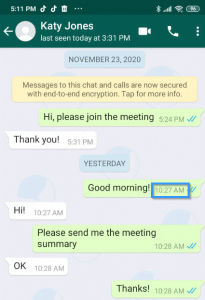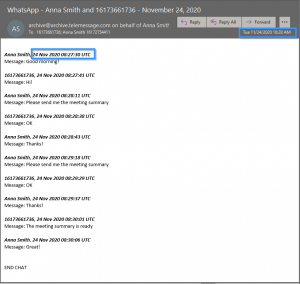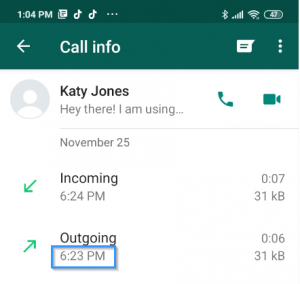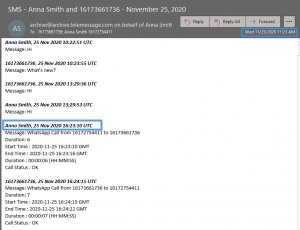1. Overview
This document will outline the way TeleMessage Mobile Archiver is timestamping archived items sent to an enterprise archive.
2. Time Stamps
TeleMessage is archiving different types of mobile communication such as text messages , media messages and voice calls.
The items are time stamped using the UTC time zone based on the actual time the messages were/sent received or an event occurred.
In case the company enterprise archive uses a time zone setting which is different than UTC. The TeleMessage mobile archived items should display according to the local time after they are translated to the time zone settings of the company enterprise archive.
2.1 Text and Media Messages
Text and media messages can be sent as SMS, MMS, TeleMessage App, WhatsApp or WeChat messages.
2.1.1 Outgoing message
The time stamp for outgoing messages represents the UTC time in which the message was sent as it was displayed in the mobile app of the end user:
Example:
- WhatsApp user located at UTC + 2 time zone (Helsinki) is sending a message at 5:05 PM local time. The app displays local time (5:05 PM). The archived message is timestamped – 3:05 PM UTC.
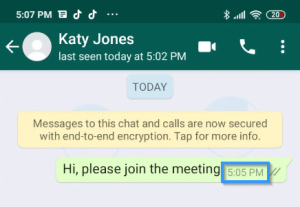
- The same message can be viewed differently according to mail client time zone setting
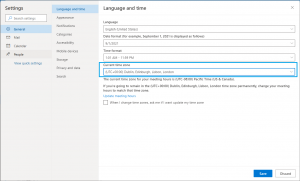
- In the example below, you can see the same message displayed with different time according to viewer settings. All 3 times are correct for the person who is viewing it.
| London Viewer | Helsinki Viewer | East cost Viewer (N.Y) | |
| Archive/Mail client time zone Settings | |||
| Displayed Time value |  |  |  |
*Note that in case your employees or the enterprise archive are under daylight saving time zones, this will be also considered when displaying the time of the messages in the enterprise archive.
2.1.2 Incoming message
The time stamp for incoming mobile message received on the mobile of the employee, will be the UTC time in which the message arrived on the mobile device.
- In the example below, the message was received at 5:31 PM, local time – UTC+2
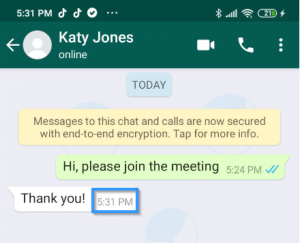
2.1.3 Message Duplication Handling
- By default, when 2 TeleMessage registered users are chatting, each one of them is sending a copy of every message to the TeleMessage Server. The Server will archive the first copy it receives. The second one will not be archived. Some companies would like to archive both of them despite the storage overhead. TeleMessage support can configure your account accordingly.
- When both copies are archived, the time stamp might be different as it might take time for the message to reach the recipient. The sender will display the sent time and the receiver will display the received time.
- When only a single copy is archived, the time stamp will represent either the sender or the receiver time. How can you know which copy was used for the archive? TeleMessage added a special xHeader just for that. X-TELEMESSAGE-ArchiveInitiator: mobile <email>.
2.1.4 Deleted Messages
- Deleted messages are archived with the same message ID as the original message that was sent. The message ID is populated in TeleMessage xHeader. Example – X-TELEMESSAGE-ArchiveMessageID: 1014697945Thu Sep 24 04:58:04 GMT 20201088
- Message media (attachment) is removed in case there was media in the original message.
- The timestamp in the archive will represent the actual deletion time.
2.2. Calls
- TeleMessage product that supports voice calls and call logs, can deliver the call metadata such as call start/end time into the enterprise archive.
2.2.1 Outgoing Calls
- The timestamp for outgoing calls represents the UTC time in which the call was dialed out from the mobile of the archiving employee.
- The call was made at 17:44 local time – UTC
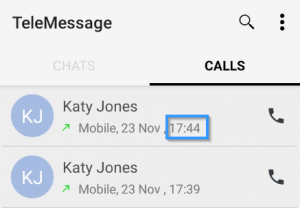
- Calls stored in the enterprise archive will display 2 types of time values.
- The time of the archived SMTP item. This value is a variable and it will change according to viewer time zone settings. See messages time stamps above for more info.
- Message body Start Time and End Time. These 2 values are not variables but rather fixed. We added the GMT time zone next to it to indicate the time zone settings of the message.
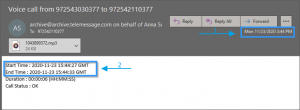
2.2.2 Incoming Call
The timestamp for incoming calls represents the UTC time in which the call was received on the mobile of the employee being archived.
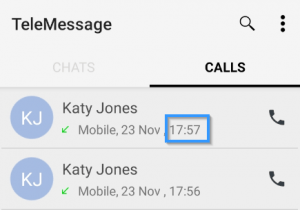
2.2.3 Calls Duplication Handling
- Calls undergo the same remove duplicates logic as messages. See Message Duplication Handling above.
2.3 Time Stamps in Thread View
- TeleMessage enabled 2 modes of archiving
- Real time archiving: Message by Message / Call by Call. Each message and call will archive rightr after their occur.
- Thread View archiving: We aggregate all messages and calls over a 24 hour interval and display them the same way they appear on the mobile apps.
2.3.1 Aggregation
- Aggregation is done for each thread in the mobile app.
- Aggregation is done once a day for the previous 24 hours interval according to the time zone configured in TeleMessage for the main company admin.
- The aggregated data in a thread will be sent to the archive once a day at around 1 hour after midnight (in the local time of the admin) for messages and calls from the previous day 23:59:59-00:00:00 in the local timezone. Example: For an admin on GMT time zone, messages that were sent on Monday at 00:80 AM GMT will archive within their thread on Tuesday after 01:00 GMT.
- Thread View includes messages and calls
- Thread View will display 2 types of time values.
- Time of the SMTP mail . This value is a variable and it will change according to viewer time zone settings. See messages time stamps above for more info. The time stamp represents the time the mail was sent. Usually after 1:00 GMT.
- Message body Start Time and End Time. These 2 values are not variables but rather fixed. We added the GMT time zone next to it to indicate the time zone settings.
